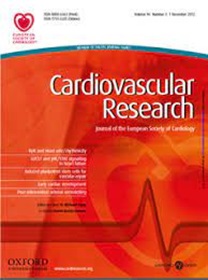Deficiency of NPR-C triggers high salt-induced thoracic aortic dissection by impairing mitochondrial homeostasis.
IF 13.3
1区 医学
Q1 CARDIAC & CARDIOVASCULAR SYSTEMS
引用次数: 0
Abstract
AIMS Thoracic aortic dissection (TAD) is a highly fatal disease lacking effective pharmacologic interventions in clinical practice. Emerging evidence indicates that the natriuretic peptide receptor C (NPR-C) plays a crucial role in the regulation of cardiovascular diseases. However, the precise involvement of NPR-C in TAD remains elusive. In this study, the role and molecular mechanisms of NPR-C in the pathogenesis of TAD were investigated. METHODS AND RESULTS Through integrated analyses of human TAD transcriptome and single-cell sequencing data sets, we identified that NPR-C was downregulated in the aortas of acute TAD patients and in beta-aminopropionitrile (BAPN)-treated mice. Intriguingly, vascular smooth muscle cell (VSMC)-specific NPR-C knockout (NPR-CSMKO) mice, rather than endothelial cell-specific NPR-C knockout mice, developed TAD after treated with angiotensin II (Ang II) plus high salt diet (HSD), but not Ang II alone. Loss of NPR-C function promoted extracellular matrix degeneration, VSMCs apoptosis and inflammation. RNA-sequencing analysis revealed that mitochondrial fatty acid oxidation (FAO) genes were significantly downregulated in the thoracic aortas of NPR-CSMKO mice treated with Ang II plus HSD. Notably, the expression of HADHB, a subunit of mitochondrial trifunctional protein (MTP) responsible for FAO, was obviously decreased in NPR-CSMKO mice treated with Ang II plus HSD. Mechanistically, knockdown of NPR-C activated ERK1/2 pathway, which decreased the expression and activity of peroxisome proliferator-activated receptor γ (PPARγ) and inhibited HADHB expression. Furthermore, NPR-C agonist, C-ANP4-23, mitigated the progression of TAD in BAPN-treated mice. Activation of MTP by spermidine (SPD) effectively prevented TAD formation in NPR-CSMKO mice treated with Ang II plus HSD. CONCLUSIONS Our data highlight a critical role of HSD in triggering TAD and a previously unrecognized role of NPR-C that protects against TAD through regulating mitochondrial homeostasis. Therefore, NPR-C activation and SPD supplementation could be new prevention and treatment strategies for TAD.缺乏NPR-C可通过损害线粒体稳态触发高盐诱导的胸主动脉夹层。
目的胸主动脉夹层(TAD)是临床上缺乏有效药物干预的高致死率疾病。越来越多的证据表明,利钠肽受体C (NPR-C)在心血管疾病的调节中起着至关重要的作用。然而,NPR-C在TAD中的确切参与仍然难以捉摸。本研究探讨了NPR-C在TAD发病中的作用及分子机制。方法与结果通过对人类TAD转录组和单细胞测序数据集的综合分析,我们发现急性TAD患者和β -氨基丙腈(BAPN)处理小鼠的主动脉中NPR-C下调。有趣的是,血管平滑肌细胞(VSMC)特异性的NPR-C敲除(NPR-CSMKO)小鼠,而不是内皮细胞特异性的NPR-C敲除小鼠,在血管紧张素II (Ang II)加高盐饮食(HSD)治疗后发生TAD,而不是单独的Ang II。NPR-C功能丧失可促进细胞外基质变性、VSMCs凋亡和炎症。rna测序分析显示,在angii + HSD处理的NPR-CSMKO小鼠胸主动脉中,线粒体脂肪酸氧化(FAO)基因显著下调。值得注意的是,在angii + HSD处理的NPR-CSMKO小鼠中,负责FAO的线粒体三功能蛋白(MTP)亚基HADHB的表达明显降低。机制上,敲低NPR-C激活ERK1/2通路,降低过氧化物酶体增殖物激活受体γ (PPARγ)的表达和活性,抑制HADHB的表达。此外,NPR-C激动剂C-ANP4-23可以减轻bapn处理小鼠TAD的进展。亚精胺(SPD)激活MTP可有效阻止Ang II + HSD处理的NPR-CSMKO小鼠TAD的形成。我们的数据强调了HSD在触发TAD中的关键作用,以及之前未被认识到的通过调节线粒体稳态来保护TAD的NPR-C的作用。因此,激活NPR-C和补充SPD可能是预防和治疗TAD的新策略。
本文章由计算机程序翻译,如有差异,请以英文原文为准。
求助全文
约1分钟内获得全文
求助全文
来源期刊

Cardiovascular Research
医学-心血管系统
CiteScore
21.50
自引率
3.70%
发文量
547
审稿时长
1 months
期刊介绍:
Cardiovascular Research
Journal Overview:
International journal of the European Society of Cardiology
Focuses on basic and translational research in cardiology and cardiovascular biology
Aims to enhance insight into cardiovascular disease mechanisms and innovation prospects
Submission Criteria:
Welcomes papers covering molecular, sub-cellular, cellular, organ, and organism levels
Accepts clinical proof-of-concept and translational studies
Manuscripts expected to provide significant contribution to cardiovascular biology and diseases
 求助内容:
求助内容: 应助结果提醒方式:
应助结果提醒方式:


